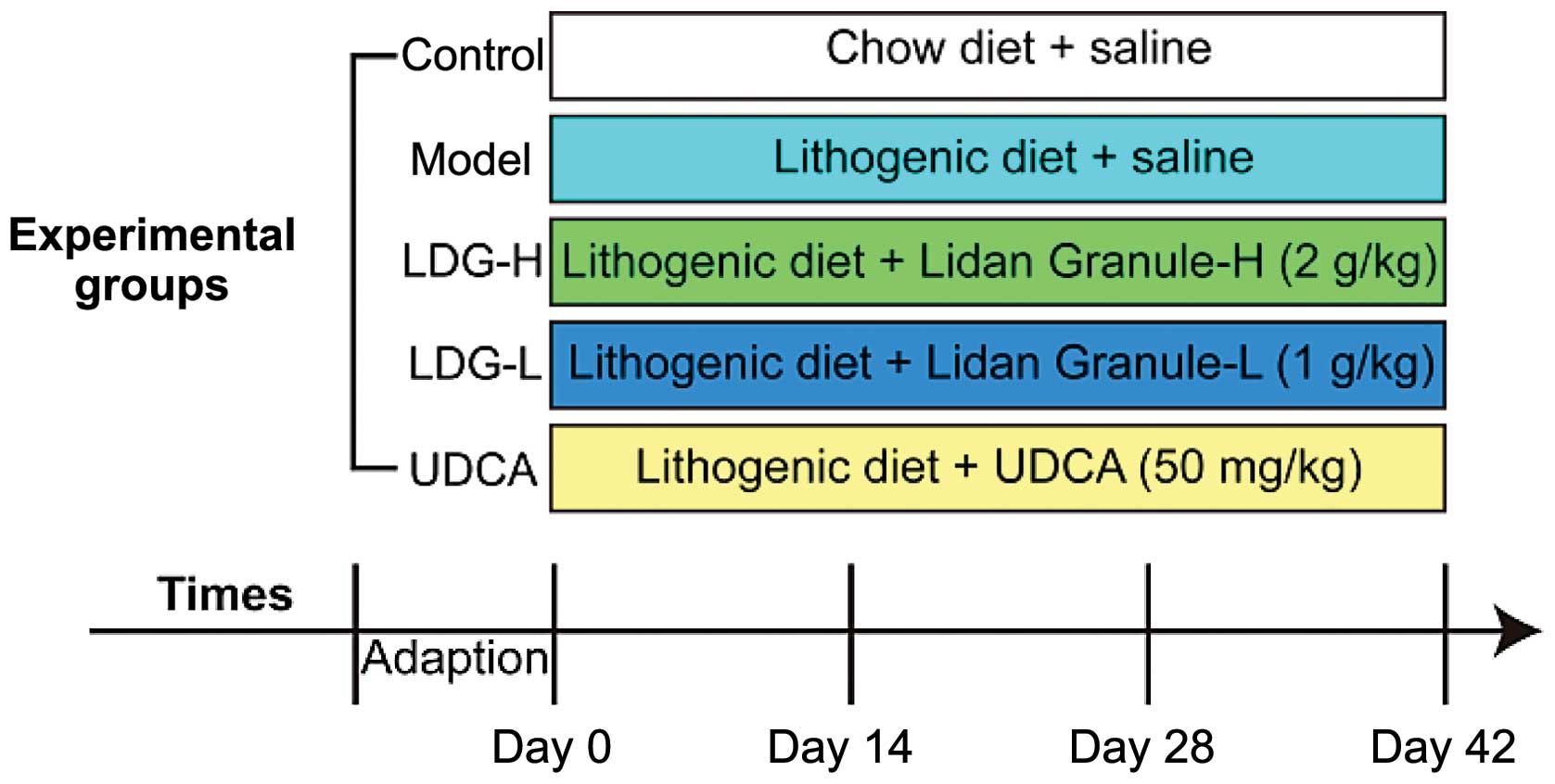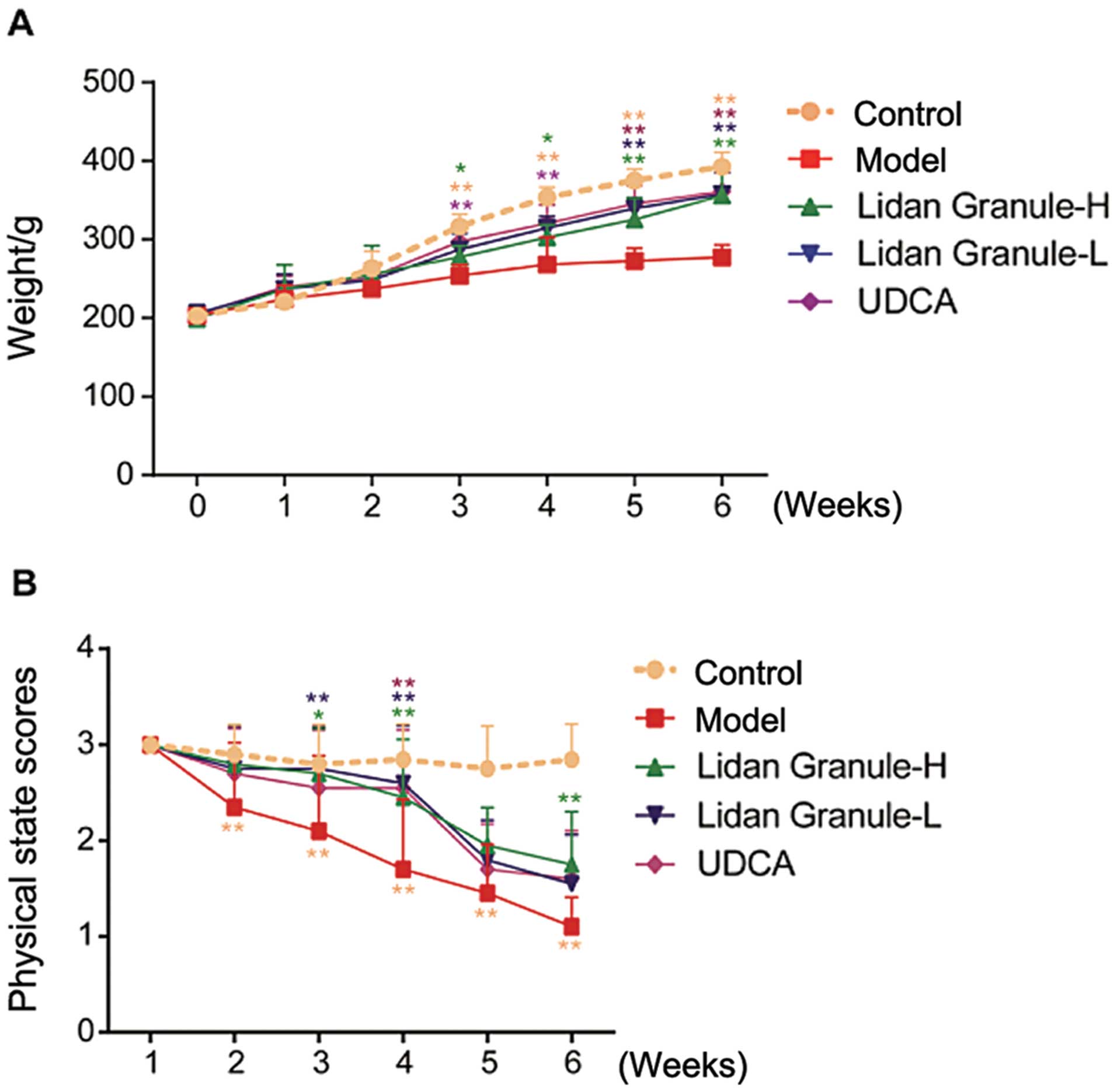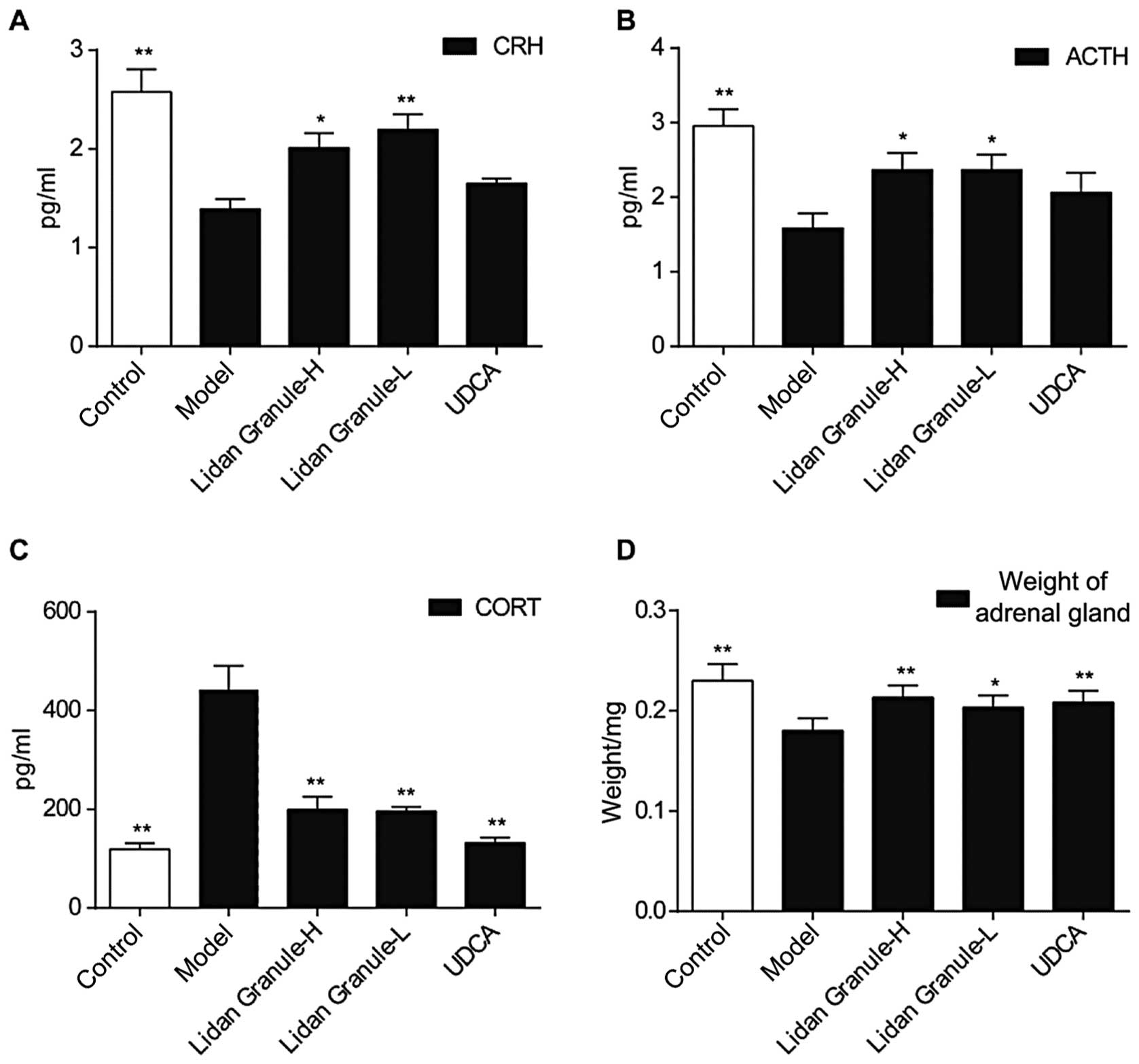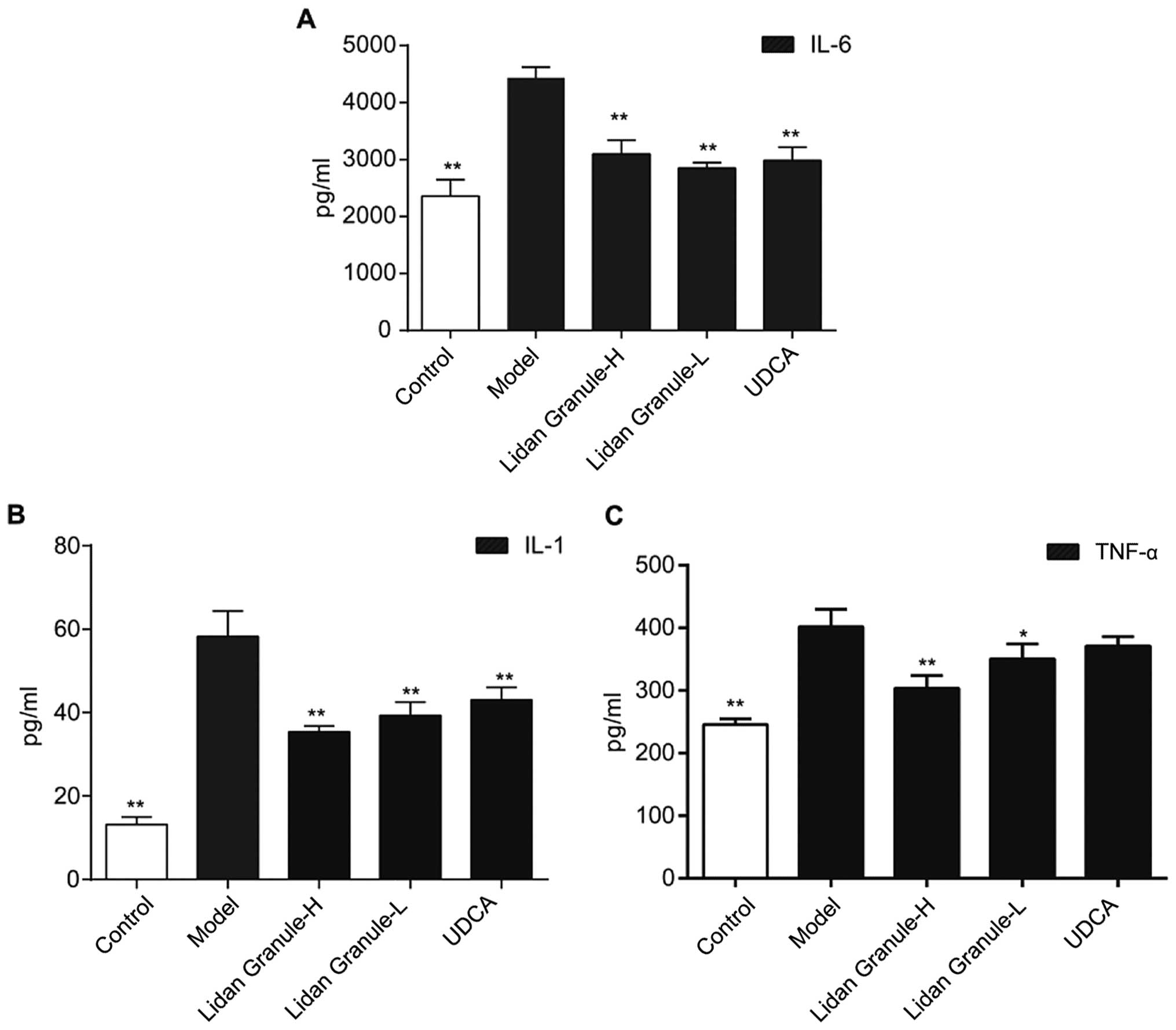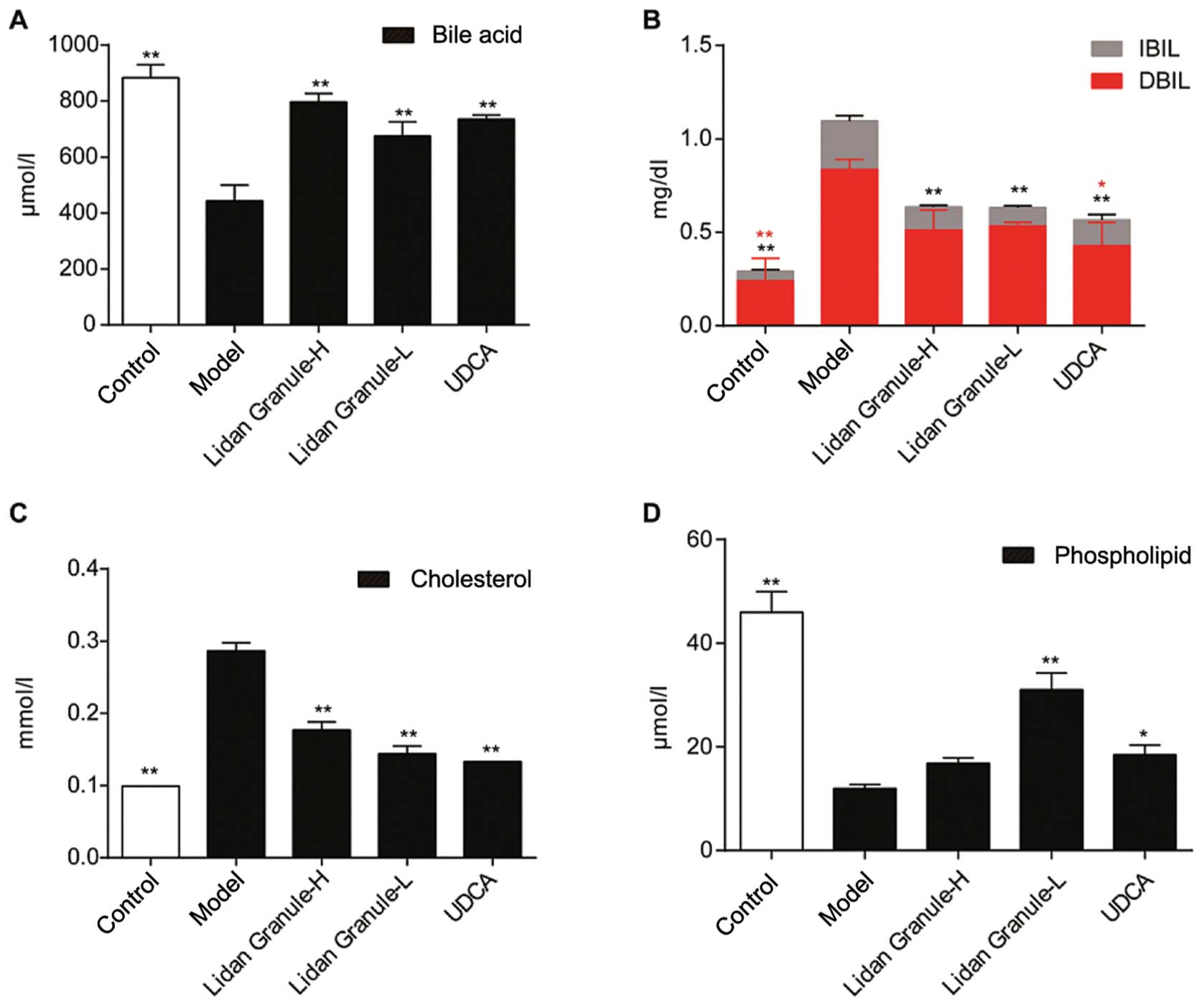Prevention of gallstones by Lidan Granule: Insight into underlying mechanisms using a guinea pig model
- Authors:
- Published online on: May 6, 2016 https://doi.org/10.3892/br.2016.672
- Pages: 50-56
-
Copyright: © Wu et al. This is an open access article distributed under the terms of Creative Commons Attribution License.
Abstract
Introduction
Gallstone disease is one of the most common gastrointestinal disorders encountered in clinical practice (1,2). Gallstones are often associated with the bile duct or intrahepatic stones, which have difficulty clearing the biliary system and are associated with a high rate of recurrence (3). Thus, prevention of the formation and recurrence of gallstones is necessary (4–7).
Gallstones are formed for many reasons. One cause is inflammation, which often changes the bile acid composition and accelerates stone formation (8,9). Previous findings have shown that inflammatory cytokines such as lipopolysaccharide (LPS), tumor necrosis factor (TNF), and interleukin-1 (IL-1) can inhibit the production of bile acid through classic and bypass pathways (9–11). Inflammatory cytokines can disturb cholate transport in the hepatocytes and reduce the secretion of bile salts and phospholipids (9).
Apart from inflammation, an imbalance in bile components such as cholesterol, bile acids, and lecithin, also contributes to gallstone formation. As the concentration of cholesterol in bile increases, the bile begins to be saturated with cholesterol, and at a certain level, the cholesterol begins to crystallize. McNeilly et al (12) found that bile acids are involved in the regulation of glucocorticoid metabolism within the liver of female patients (12,13). The increased level of bile acids during cholestasis may induce the downregulation of the hypothalamic-pituitary-adrenal (HPA) axis. The HPA axis plays a role in the body's response to stress by mediating the secretion of the adrenocorticotropic hormone (ACTH). Clinical studies have shown that gallstone disease is associated with dysregulation of the HPA axis with abnormal secretion of serum corticosterone (14). Thus, homeostasis of the HPA axis is important for the prevention of pigment gallstones.
In traditional Chinese medicine, gallstone refers to ‘rib pain’ or ‘liver bilges’, and the treatment of gallstones is based on the principle of ‘liver-dispersing and bile discharging,’ i.e., stone clearance and restoration of liver function. Lidan Granule (LDG) is formulated on the basis of these principles and consists of 15 types of Chinese herbs. It has been used for many years in clinical practice to treat and prevent gallstones (4,15,16). The aim of the present study was to investigate the role of LDG in the treatment and prevention of pigment gallstones and to explore the underlying mechanisms using a guinea pig model.
Materials and methods
Drugs and reagents
LDG was provided by the Department of the Integrative Medicine, Huashan Hospital, Fudan University (Shanghai, China), and the components and efficacy of LDG are described in Table I. Ursodeoxycholic acid (UDCA) was purchased from Sanwei Changjiang Biochemical Pharmaceutical Factory (Shanghai, China), and the enzyme-linked immunosorbent assay (ELISA) kits were obtained from eBioscience, Inc. (San Diego, CA, USA). The lithogenic diet food (the components of which are listed in Table II) was purchased from Trophic Animal Feed High-tech Co., Ltd. (Jiangsu, China). LDG and UDCA were diluted in sterile saline. Animals in the LDG-H (2 g/kg/day, determined by the dosage used for humans clinically), LDG-L (1 g/kg/day), and UDCA (50 mg/kg/day) groups were fed twice per day.
Animals and treatments
One hundred male guinea pigs (weighing 230–250 g) were obtained from the Shanghai SLAC Laboratory Animal Co., Ltd. (Shanghai, China). Animals were maintained in a temperature- (20±2°C) and humidity- (50–60%) controlled facility upon arrival on a 12-h light/dark cycle (lights on from 7:00 a.m. to 7:00 p.m.) and given access to food and water ad libitum. Animals were randomly divided into five groups. The control group mice were fed a chow diet, whereas mice in the other groups were fed a high cholesterol lithogenic diet (17,18). The LDG-H group was fed with a lithogenic diet and LDG (2 g/kg/day), given orally, and the LDG-L group was fed the lithogenic diet and LDG (1 g/kg/day), given orally (Fig. 1). The UDCA group was fed UDCA (50 mg/kg/day), and the model group was fed with lithogenic diet and saline. Experiment animals were housed for a minimum of 7 days prior to the start of the experiment to adapt to the environment. Experiments were conducted in accordance with the guidelines of the Animal Care and Use Committee of Fudan University.
Serum, bile, and histological sample preparation
The animals were sacrificed by an overdose of sodium pentobarbital (50 mg/kg body weight, i.p.), and blood samples were obtained from the aorta abdominal and clotted for 2 h at room temperature before centrifugation (1,006.2 × g at 4°C for 10 min). The supernatant was subsequently collected and stored at −80°C for measurement of the levels of IL-6, IL-1, TNF-α, and cortisol (CORT) in the peripheral blood. The guinea pigs were decapitated, and the brain tissues were removed and stored on ice. The bilateral hippocampus and hypophysis were rapidly and carefully removed using curved tweezers. Once snap frozen in liquid nitrogen, the brain tissue samples were stored at −80°C until use. The adrenal glands of guinea pigs were also removed and weighed carefully.
Bile samples were obtained from dissected gall bladders, stored at −20°C, and diluted 1:5 with distilled water prior to analysis by ultra-performance liquid chromatography-mass spectrometry (UPLC-MS).
Physical state score (PSS)
The physical states of the guinea pigs in the different groups were assessed as previously described (19). The physical states of guinea pigs were evaluated weekly until the end of the experiment. The coat state was recorded on a scale from 1 to 3 as follows: guinea pigs in a good state were scored as 3 (the fur was smooth with no tousling), animals in a bad state were scored as 1 (dirty fur on most of the body), and those with a coat state between 1 and 3 were scored as 2. Each measurement was scored by another experimenter blinded to the treatment group.
Serum CORT, corticotrophin-releasing hormone (CRH), IL-6, and ACTH ELISA
Serum levels of CORT, IL-6, IL-1, and TNF-α were measured using a commercially available enzyme competitive ELISA test kit following the manufacturer's instructions (eBioscience, Inc.).
Statistical analysis
Data were presented as mean ± standard error of the mean and analyzed with SPSS 17.0 software (SPSS, Inc., Chicago, IL, USA). The statistical significance of differences between the means of groups was determinant by one-way analysis of variance (ANOVA) followed by the least significant difference (LSD) for post-hoc comparisons. The rate of different groups were compared with the Chi-square test. P<0.05 was considered to indicate a statistically significant difference.
Results
Effect on weight, PSS change, and the rate of gallstone formation
During 6 weeks of exposure to a lithogenic diet, guinea pigs in the model group showed a mild increase in weight, whereas those on low concentration (1 g/kg) or high concentration (2 g/kg) of LDG showed an obvious increase in weight after 2 weeks (Fig. 2A). Six weeks later, the differences in weights between the model and LDG groups were significant (both P<0.01). The PSS score of the model group guinea pigs decreased during the 6-week experiment, and the PSS score was statistically different between the control and model groups (P<0.01) beyond the second week. The PSS scores for the treatment groups were reduced significantly during the fourth and fifth weeks (Fig. 2B).
Six weeks later, the rate of gallstone formation was 5.56% among 18 guinea pigs in the control group (Table III). For the model group, the stone formation rate was 81.25%, which was significantly higher than that in the control group (P<0.01; Table III). Four of 13 guinea pigs developed gallstones in the UDCA group (P<0.05), and the stone formation rates in the LDG-H and LDG-L groups were 14.29% (P<0.01) and 21.43% (P<0.01), respectively. The rates were lower than the stone formation rate observed in the model group (Table III).
Effect on histopathological assessment of liver tissues
After 6 weeks of treatment, normal hepatocytes with blue-stained nuclei located in the center of the cell and arranged in cord-like patterns were evident in the control group (Fig. 3A and A1). In the pigment gallstone model group, hepatic steatosis in the form of fat globules in the hepatocytes with an eccentric nucleus and loose cytoplasm was observed. Many inflammatory cells were dispersed around the central vein, and small Mallory bodies were identified at higher magnification (Fig. 3B and B1). Compared to the control group, the LDG-H (2 g/kg/day; Fig. 3C and C1) and LDG-L (1 g/kg/day; Fig. 3D and D1) groups showed fewer inflammatory cells, and no obvious ballooning degeneration. Similar findings were observed in the UDCA group (Fig. 3E and E1), except for the presence of ballooning degeneration in a few areas around the central vein.
Effect of LDG on HPA axis activation
As shown in Fig. 4, 6 weeks of the lithogenic diet increased the CORT concentration in serum (P<0.01) compared to that in the control group and decreased the level of CRH in the hypothalamus (P<0.01) and expression of ACTH in the hypophysis (P<0.01). The lithogenic diet also had some effect on the weight of the adrenal gland (P<0.01). Six weeks of treatment with LDG (2 and 1 g/kg/day) significantly improved the disturbance in the HPA axis caused by the lithogenic diet. Similarly, UDCA had a positive effect on the level of CORT in the peripheral blood (P<0.01) and the weight of the adrenal gland (P<0.01).
Effect of LDG on IL-6, IL-1, and TNF-α levels in peripheral blood
The levels of IL-6, IL-1, and TNF-α in the peripheral blood were increased after 6 weeks on a lithogenic diet. Following treatment with high- or low-dose LDG, decreases in the serum concentration of IL-6 (Fig. 5A; P<0.01), IL-1 (Fig. 5B; P<0.01), and TNF-α (Fig. 5C; P<0.01) were observed.
Effect of LDG on the bile components
As expected, the lithogenic diet increased the concentration of cholesterol, direct bilirubin (DBIL), and indirect bilirubin (IBIL) in the bile and reduced the bile concentrations of bile acids and phospholipids (Fig. 6A and D). However, LDG significantly reduced the cholesterol, IBIL, and DBIL concentrations in the bile (Fig. 6B; P<0.01). At the same time, LDG increased the acid concentration in the bile (Fig. 6A; P<0.01) after 6 weeks of treatment.
Discussion
The results of the present study suggest that a lithogenic diet can induce the formation of gallstones and disturb the HPA axis in guinea pigs, whereas LDG can ameliorate the effect of a lithogenic diet on the HPA axis and bile components.
Most gallstones are formed in the bile duct system, where they can block the bile duct and lead to cholestasis (20). During the disease process, cholestasis results in a decrease in liver function, and also, endocrine function (21). The diet is one of the most common pathogenic factors for gallstone formation. Thus, in our study, a lithogenic diet was given to guinea pigs for 6 weeks to induce the formation of pigment gallstones (22). After 6 weeks, serum IL-6, IL-1, and TNF-α levels in the model group were found to be elevated, while the histopathological examination of the livers showed hepatic steatosis and loose cytoplasm, with nuclei pushed to the edge of cells and inflammatory cell infiltration occurring. These findings confirm that the pigment gallstone model is suitable for studying the pathophysiology of pigment stone formation.
LDG has been used as a routine treatment for gallstones for many years, and clinical studies have demonstrated that LDG can promote biliary excretion and litholysis (15). LDG is composed of 15 types of Chinese herbs, namely, oriental wormwood, hawthorn fruit, rice sprout, germinated barley, green orange peel, tangerine peel, medicated leaven, cyperus tuber, radish seed, perilla stem, turmeric root, bitter orange, pinellia tube, and Chinese honey locust fruit, which is based on the Chinese medicinal principle of smoothening liver function, dredging the gallbladder, harmonizing the stomach, and strengthening the spleen (23).
The neuroendocrine system plays an important role in maintaining homeostasis (14). A clinical study has shown that gallstone formation in patients is always followed by endocrine disturbance, and changes in the corticosterone levels may indicate the presence of gallstone disease (24). In our study, after 6 weeks on a lithogenic diet, the CORT level in the model group was increased along with disruption of the HPA axis and a change in the weight of the adrenal gland. LDG treatment can ameliorate the secretion of proteins in the HPA axis, which means that LDG can regulate the neuroendocrine system during the process of gallstone formation.
IL-6 is one of the most important inflammatory biomarkers of cholelith disease (9,25). In our study, serum IL-6 levels in the model group were elevated. Previous findings have shown that IL-6 in combination with other inflammatory cytokines or alone can influence the action of the HPA axis at different levels (26), which may explain the reason HPA axis dysfunction being considered in cholelith disease. LDG can improve the inflammatory state of guinea pigs by reducing the amounts of serum IL-6, IL-1, and TNF-α, and improving the function of the neuroendocrine system at the same time.
Bile components are an important factor for the clinical diagnosis and differential diagnosis of gallstone disease (27,28). In our study, the DBIL of the model group was higher than that of other groups, and it was in agreement with the clinical characteristics of silt-type cholesterol gallstones. After 6 weeks of LDG treatment, the DBIL was reduced significantly in the study group, which proves the dredging action of LDG.
In conclusion, the present study confirmed that cholelith disease is always accompanied by dysregulation of the HPA axis. LDG cannot only regulate the excretion of inflammatory factors but also improve the function of the neuroendocrine system, and improve the composition of the bile. LDG may influence the lithogenic character of bile via multiple pathways and has a definite role in the prevention and treatment of cholelithiasis.
Acknowledgements
The present study was funded by grants from the Development Project of Shanghai Peak Disciplines-Integrated Chinese and Western Medicine, the Doctoral Program of Higher Education of China (no. 20120071120076), the National Science Foundation for Distinguished Young Scholars of China (grant no. 81403148), and the National Science Foundation for Distinguished Young Scholars of China (grant no. 81501180).
References
|
Erichsen R, Frøslev T, Lash TL, Pedersen L and Sørensen HT: Long-term statin use and the risk of gallstone disease: a population-based case-control study. Am J Epidemiol. 173:162–170. 2011. View Article : Google Scholar : PubMed/NCBI | |
|
Stinton LM and Shaffer EA: Epidemiology of gallbladder disease: cholelithiasis and cancer. Gut Liver. 6:172–187. 2012. View Article : Google Scholar : PubMed/NCBI | |
|
Markar SR, Karthikesalingam A, Thrumurthy S, Muirhead L, Kinross J and Paraskeva P: Single-incision laparoscopic surgery (SILS) vs. conventional multiport cholecystectomy: systematic review and meta-analysis. Surg Endosc. 26:1205–1213. 2012. View Article : Google Scholar : PubMed/NCBI | |
|
Zhang SB and Fang BJ: Effects of Yanggan Lidan Granule on rate of gallstone formation and content of plasma cholecystokinin in guinea pigs with induced cholesterol gallstones. Zhong Xi Yi Jie He Xue Bao. 6:405–408. 2008.(In Chinese). View Article : Google Scholar : PubMed/NCBI | |
|
Mann KS, Welfare E, Hughes D, et al: Significant service reconfiguration is required to definitively treat gallstone pancreatitis and prevent serious complications. Br J Surg. 99:164–165. 2012.PubMed/NCBI | |
|
Smelt AH: Triglycerides and gallstone formation. Clin Chim Acta. 411:1625–1631. 2010. View Article : Google Scholar : PubMed/NCBI | |
|
You SF, Zheng PY, Ji G, Wei HF, Zhao J and Zhu PT: Protective effects of yanggan lidan granules on carbon tetrachloride-induced liver damage in mice. Zhong Xi Yi Jie He Xue Bao. 3:470–472. 2005.(In Chinese). View Article : Google Scholar : PubMed/NCBI | |
|
Wang SN, Yeh YT, Wang ST, Chuang SC, Wang CL, Yu ML and Lee KT: Visfatin - a proinflammatory adipokine-in gallstone disease. Am J Surg. 199:459–465. 2010. View Article : Google Scholar : PubMed/NCBI | |
|
Maurer KJ, Carey MC and Fox JG: Roles of infection, inflammation, and the immune system in cholesterol gallstone formation. Gastroenterology. 136:425–440. 2009. View Article : Google Scholar : PubMed/NCBI | |
|
Kasprzak A, Szmyt M, Malkowski W, Przybyszewska W, Helak-Łapaj C, Seraszek-Jaros A, Surdacka A, Małkowska-Lanzafame A and Kaczmarek E: Analysis of immunohistochemical expression of proinflammatory cytokines (IL-1α, IL-6, and TNF-α) in gallbladder mucosa: Comparative study in acute and chronic calculous cholecystitis. Folia Morphol (Warsz). 74:65–72. 2015. View Article : Google Scholar : PubMed/NCBI | |
|
Chai J, He Y, Cai SY, Jiang Z, Wang H, Li Q, Chen L, Peng Z, He X, Wu X, et al: Elevated hepatic multidrug resistance-associated protein 3/ATP-binding cassette subfamily C 3 expression in human obstructive cholestasis is mediated through tumor necrosis factor alpha and c-Jun NH2-terminal kinase/stress-activated protein kinase-signaling pathway. Hepatology. 55:1485–1494. 2012. View Article : Google Scholar : PubMed/NCBI | |
|
McNeilly AD, Macfarlane DP, O'Flaherty E, Livingstone DE, Mitić T, McConnell KM, McKenzie SM, Davies E, Reynolds RM, Thiesson HC, et al: Bile acids modulate glucocorticoid metabolism and the hypothalamic-pituitary-adrenal axis in obstructive jaundice. J Hepatol. 52:705–711. 2010. View Article : Google Scholar : PubMed/NCBI | |
|
Soliman HM, Abd El-Haleem MR and El Tarhouny SA: Histomorphometrical and Electron Microscopic Study of Adrenocorticocytes Following Surgically Induced Extrahepatic Biliary Obstruction in Adult Female Albino Rats: Histomorphometrical and electron microscopic study of adrenocorticocytes following surgically induced extrahepatic biliary obstruction in adult female albino rats. Folia Biol (Praha). 61:14–25. 2015.PubMed/NCBI | |
|
Rose AJ, Berriel Díaz M, Reimann A, Klement J, Walcher T, Krones-Herzig A, Strobel O, Werner J, Peters A, Kleyman A, et al: Molecular control of systemic bile acid homeostasis by the liver glucocorticoid receptor. Cell Metab. 14:123–130. 2011. View Article : Google Scholar : PubMed/NCBI | |
|
Xiang Y, Chen JH, Cai D and Ma BJ: Effect of Lidan Granule on bile lithogenesis in patients with choledocholithiasis combined with cholecystolithiasis. Chin J Integr Med. 14:142–144. 2008. View Article : Google Scholar : PubMed/NCBI | |
|
Zuo YT, Gao WY, Jia W, Duan HQ and Xiao PG: Prevention and treatment of cholelithiasis by traditional Chinese medicine. Zhongguo Zhong Yao Za Zhi. 29:831–833, 910. 2004.(In Chinese). PubMed/NCBI | |
|
Wang HH, Portincasa P, Mendez-Sanchez N, Uribe M and Wang DQ: Effect of ezetimibe on the prevention and dissolution of cholesterol gallstones. Gastroenterology. 134:2101–2110. 2008. View Article : Google Scholar : PubMed/NCBI | |
|
Song XY, Xu S, Hu JF, Tang J, Chu SF, Liu H, Han N, Li JW, Zhang DM, Li YT, et al: Piperine prevents cholesterol gallstones formation in mice. Eur J Pharmacol. 751:112–117. 2015. View Article : Google Scholar : PubMed/NCBI | |
|
Alonso R, Griebel G, Pavone G, Stemmelin J, Le Fur G and Soubrié P: Blockade of CRF(1) or V(1b) receptors reverses stress-induced suppression of neurogenesis in a mouse model of depression. Mol Psychiatry. 9:278–286, 224. 2004. View Article : Google Scholar : PubMed/NCBI | |
|
Zhu L, Aili A, Zhang C, Saiding A and Abudureyimu K: Prevalence of and risk factors for gallstones in Uighur and Han Chinese. World J Gastroenterol. 20:14942–14949. 2014. View Article : Google Scholar : PubMed/NCBI | |
|
Wittenburg H: Hereditary liver disease: gallstones. Best Pract Res Clin Gastroenterol. 24:747–756. 2010. View Article : Google Scholar : PubMed/NCBI | |
|
Méndez-Sánchez N, Zamora-Valdés D, Chávez-Tapia NC and Uribe M: Role of diet in cholesterol gallstone formation. Clin Chim Acta. 376:1–8. 2007. View Article : Google Scholar : PubMed/NCBI | |
|
Fang BJ, Zhou S, Pei XJ, Huang JY, Chen BJ, Geng Y and Yang LK: Effects of Yanggan Lidan Granule on insulin resistance in guinea pigs with induced cholesterol gallstones. Zhong Xi Yi Jie He Xue Bao. 7:1159–1163. 2009.(In Chinese). View Article : Google Scholar : PubMed/NCBI | |
|
No authors listed: Current bibliographies of neuropeptides prepared by the University of Sheffield Biomedical Information Service. Neuropeptides. 29:B37–B49. 1995.PubMed/NCBI | |
|
Yun JW, Kim JS, Choi WS, et al: Inhibition of sphingolipid pathway affects the formation of cholesterol gallstone by the modulation of Il-6/Stat3 pathway in mice model. J Gastroenterol Hepatol. 27:85–86. 2012.PubMed/NCBI | |
|
Rosenblat JD, Cha DS, Mansur RB and McIntyre RS: Inflamed moods: a review of the interactions between inflammation and mood disorders. Prog Neuropsychopharmacol Biol Psychiatry. 53:23–34. 2014. View Article : Google Scholar : PubMed/NCBI | |
|
Peng Y, Yang Y, Liu Y, Nie Y, Xu P, Xia B, Tian F and Sun Q: Cholesterol gallstones and bile host diverse bacterial communities with potential to promote the formation of gallstones. Microb Pathog. 83–84:57–63. 2015. View Article : Google Scholar | |
|
Halilbasic E, Claudel T and Trauner M: Bile acid transporters and regulatory nuclear receptors in the liver and beyond. J Hepatol. 58:155–168. 2013. View Article : Google Scholar : PubMed/NCBI |



